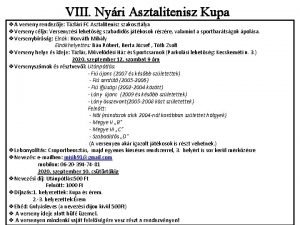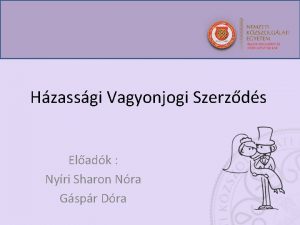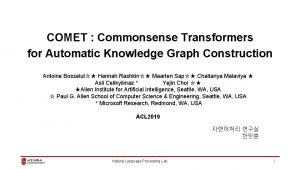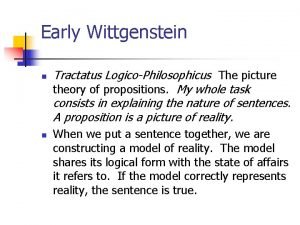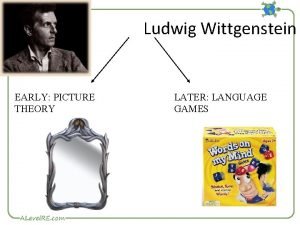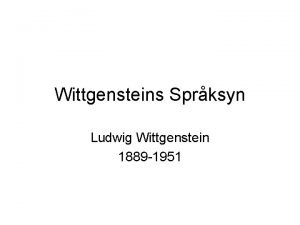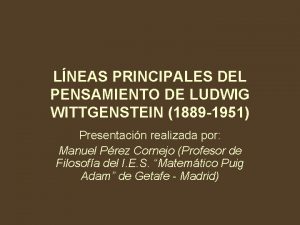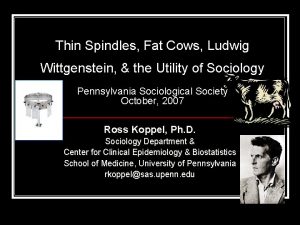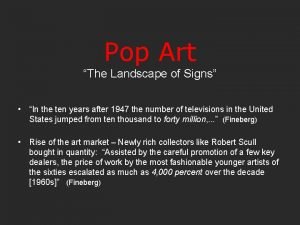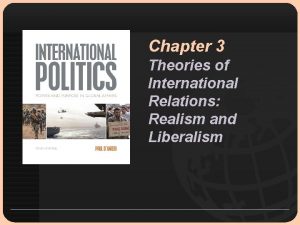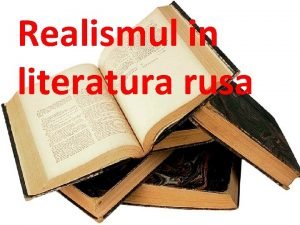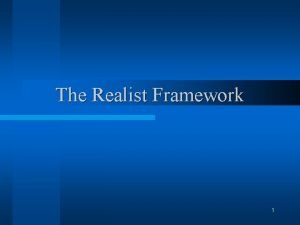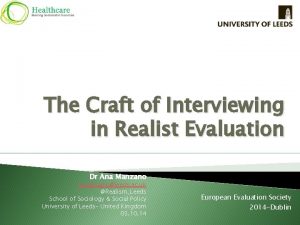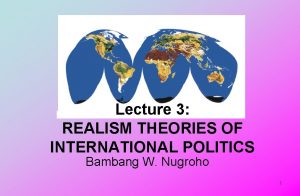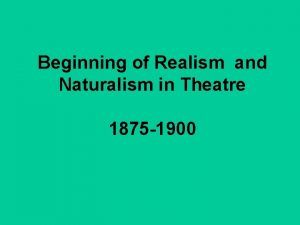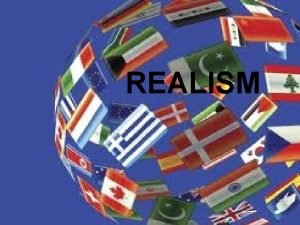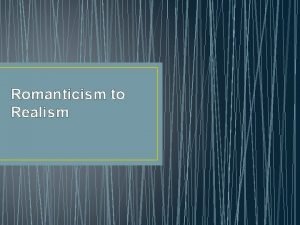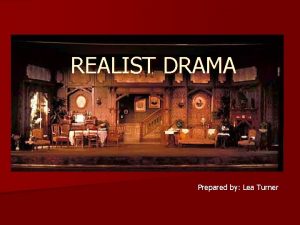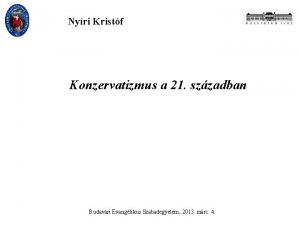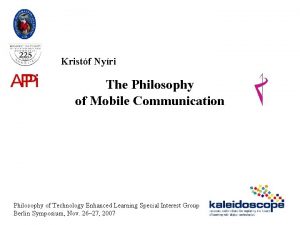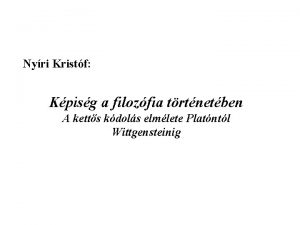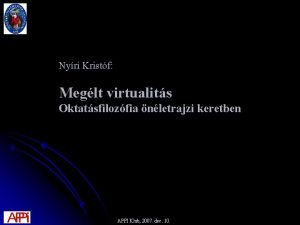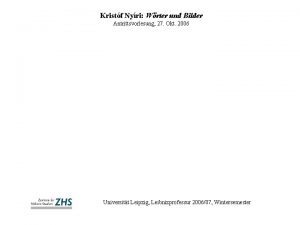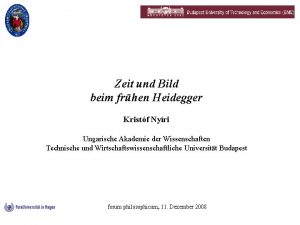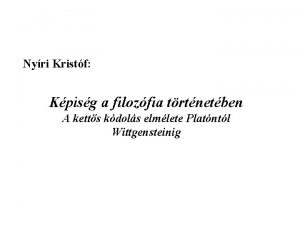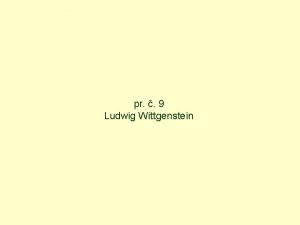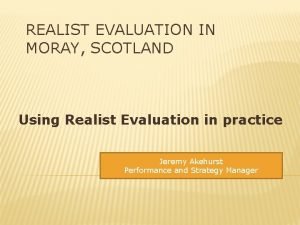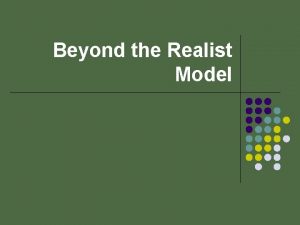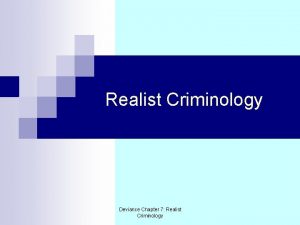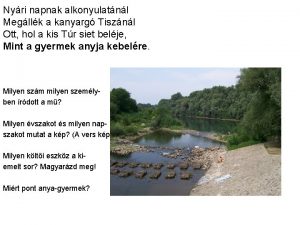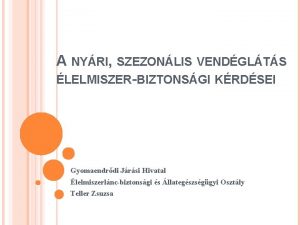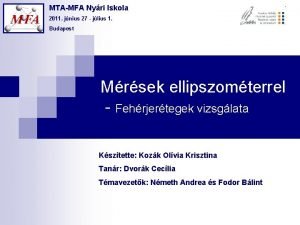Kristf Nyri Was Wittgenstein a CommonSense Realist 1
























- Slides: 24

Kristóf Nyíri: Was Wittgenstein a Common-Sense Realist? 1. Wittgenstein as a Visual Thinker 2. Some Remarks on the Wittgenstein Corpus 3. Interposed Question: What Is Common-Sense Philosophy? 4. Why Does It Matter Whether Wittgenstein Was a Common-Sense Realist? 4. 1. The Iconic Turn Aspect 4. 2. The Boghossian Formula 5. Common-Sense Realism in The Blue Book 6. Common-Sense Realism in On Certainty 6. 1. Wittgenstein on Moore 6. 2. Boghossian on On Certainty 6. 2. 1. Wittgenstein Not a Constructivist 7. Common-Sense Philosophy in the Philosophical Investigations 8. Conclusion 8. 1. Boghossian on Observational Propositions 8. 2. Wittgenstein’s Common-Sense Realism Weakened by His Insufficient Grasp of the Visual 5 th Visual Learning Conference – Budapest, Nov. 14– 15, 2014

Kristóf Nyíri: Was Wittgenstein a Common-Sense Realist ? 1. Wittgenstein as a Visual Thinker Wittgenstein was not only a visual thinker, but also a thinker who in his later years came close to developing a philosophy of visual thinking. The position he was groping for corresponds to the common-sense view: we think in images no less than in words, and both mental and physical images signify by resembling. 5 th Visual Learning Conference – Budapest, Nov. 14– 15, 2014

Kristóf Nyíri: Was Wittgenstein a Common-Sense Realist ? 1. Wittgenstein as a Visual Thinker Wittgenstein was not only a visual thinker, but also a thinker who in his later years came close to developing a philosophy of visual thinking. The position he was groping for corresponds to the common-sense view: we think in images no less than in words, and both mental and physical images signify by resembling. Nyíri, “Wittgenstein’s Philosophy of Pictures”, 2001 Nyíri, “Image and Metaphor in the Philosophy of Wittgenstein”, 2010 5 th Visual Learning Conference – Budapest, Nov. 14– 15, 2014

Kristóf Nyíri: Was Wittgenstein a Common-Sense Realist ? 1. Wittgenstein as a Visual Thinker Wittgenstein was not only a visual thinker, but also a thinker who in his later years came close to developing a philosophy of visual thinking. The position he was groping for corresponds to the common-sense view: we think in images no less than in words, and both mental and physical images signify by resembling. Nyíri, “Wittgenstein’s Philosophy of Pictures”, 2001 Nyíri, “Image and Metaphor in the Philosophy of Wittgenstein”, 2010 Wittgenstein a visual thinker: think of his innumerable drawings… Think of his early picture theory of language… Wittgenstein a philosopher of visual thinking… The Blue Book: “pictures of which we should say that we understand them immediately, without any further interpretation” – The Brown Book: pictures playing an essential role in our system of communication – “PI, Part II”: our direct reactions to “picture-objects”… Br. B: “PI, Part II”: 5 th Visual Learning Conference – Budapest, Nov. 14– 15, 2014

Kristóf Nyíri: Was Wittgenstein a Common-Sense Realist ? 1. Wittgenstein as a Visual Thinker Wittgenstein a philosopher of visual thinking… PI, §§ 422– 24, discussing the “picture” – the simile – of the human soul: “… there is a picture in the foreground, but the sense lies far in the background; that is, the application of the picture is not easy to survey. … The picture is there; and I do not dispute its correctness. But what is its application? Think of the picture of blindness as a darkness in the soul or in the head of the blind man. ” MS 116, p. 325, May 1944 5 th Visual Learning Conference – Budapest, Nov. 14– 15, 2014

Kristóf Nyíri: Was Wittgenstein a Common-Sense Realist ? 2. Some Remarks on the Wittgenstein Corpus What did the later Wittgenstein as a matter of fact publish? His lectures and dictations were a form of publication… Bl. B, Br. B » Preliminary Studies for the “Philosophical Investigations” « is entirely misguided and misleading. In 2001 I wrote: “the later Wittgenstein at no stage of his thinking possessed [a] unified philosophy. He had significant insights, but no clear views as to what his problems actually were, or what he was striving to achieve. ” “Part II” was never intended by Wittgenstein as a sequel to “Part I” of PI, and the designation “Part II” has been in fact dropped in the Schulte–Hacker edition. But MS 144 is still special: “Fair manuscript copy containing Part II of the Investigations. 1949” (von Wright); “Wittgenstein regarded the typescript for Part II as a more finished product than the other typescripts which he had dictated after the typescript for Part I” (von Wright); “carefully selected excerpts …, originally gathered as readings for Norman Malcolm and his students when visiting Cornell” in 1949 (Stern); “to show … Malcolm his current work” (Hacker–Schulte). 5 th Visual Learning Conference – Budapest, Nov. 14– 15, 2014

Kristóf Nyíri: Was Wittgenstein a Common-Sense Realist ? 2. Some Remarks on the Wittgenstein Corpus … with very partial antecedents in MS 137, 1948/49… 5 th Visual Learning Conference – Budapest, Nov. 14– 15, 2014

Kristóf Nyíri: Was Wittgenstein a Common-Sense Realist ? 2. Some Remarks on the Wittgenstein Corpus MS 137, p. 16 a, 1948/49 5 th Visual Learning Conference – Budapest, Nov. 14– 15, 2014

Kristóf Nyíri: Was Wittgenstein a Common-Sense Realist ? On C ertai nty (M S 174 ), § 1 3 7 2. Some Remarks on the Wittgenstein Corpus 5 th Visual Learning Conference – Budapest, Nov. 14– 15, 2014

Kristóf Nyíri: Was Wittgenstein a Common-Sense Realist ? 3. Interposed Question: What Is Common-Sense Philosophy? Common sense is an everevolving product of history, in the constitution of which both the science, and the philosophies, of earlier ages play a significant part it is current science that provides valid data about the world and constructs workable theories to incorporate those data common-sense philosophy is not the philosophy of the common man in the street, but rather the philosophy that makes sense to educated non-philosophers but it is philosophy, as building both on current science, and on the history of philosophy, that tells us what the world is like (gives us a “world-view”) 5 th Visual Learning Conference – Budapest, Nov. 14– 15, 2014

Kristóf Nyíri: Was Wittgenstein a Common-Sense Realist ? 4. Why Does It Matter Whether Wittgenstein Was a ts: s i tiv Common-Sense Realist? c u str n 4. 1. The Iconic Turn Aspect o c g n i 4. 2. The Boghossian Formula ort ad r e t … l ib ome ic t s s y l a po verc n y a he log not o on tem as is n s a i i p si b e s t o c lis uisti gh a o e B e r ling l b i e eas as th f No long as sup n itio p 2006 5 th Visual Learning Conference – Budapest, Nov. 14– 15, 2014

Kristóf Nyíri: Was Wittgenstein a Common-Sense Realist ? 5. Common-Sense Realism in The Blue Book “a host of philosophical difficulties which threaten to break up all our commonsense notions about what we should commonly call the objects of our experience. … We are tempted to think that in order to clear up such matters philosophically our ordinary language is too coarse… … a kind of parable illustrating the difficulty we are in, and also showing the way out of this sort of difficulty: We have been told by popular scientists that the floor on which we stand is not solid, as it appears to common sense, as it has been discovered that the wood consists of particles filling space so thinly that it can almost be called empty. This is liable to perplex us… To say … that the floor is not solid is to misuse language. … … the common-sense philosopher – … not the common-sense man, who is as far from realism as from idealism… … apparent analogy, and again the lack of analogy, … which causes our trouble. And it is this troublesome feature in our grammar which the realist does notice. ” ––“There is no common sense answer to a philosophical problem. One can defend common sense against the attacks of philosophers only by solving their puzzles, i. e. , by curing them of the temptation to attack common sense; not by restating the views of common sense. A philosopher is not a man out of his senses, a man who doesn't see what everybody sees; nor on the other hand is his disagreement with common sense that of the scientist disagreeing with the coarse views of the man in the street. ” 5 th Visual Learning Conference – Budapest, Nov. 14– 15, 2014

Kristóf Nyíri: Was Wittgenstein a Common-Sense Realist ? 6. Common-Sense Realism in On Certainty 6. 1. Wittgenstein on Moore 6. 2. Boghossian on On Certainty 6. 2. 1. Wittgenstein Not a Constructivist 5 th Visual Learning Conference – Budapest, Nov. 14– 15, 2014

Kristóf Nyíri: Was Wittgenstein a Common-Sense Realist ? 6. Common-Sense Realism in On Certainty 6. 1. Wittgenstein on Moore From G. E. Moore, “Proof of an External World” (1939): “I can prove now, for instance, that two human hands exist. How? By holding up my two hands, and saying, as I make a certain gesture with the right hand, "Here is one hand", and adding, as I make a certain gesture with the left, "and here is another". … the proof which I gave was a perfectly rigorous one… … the premiss … I expressed by showing you my hands, making certain gestures, and saying the words "here is one hand, and here is another”. ” From the “Introduction” of OC: In 1949 “Malcolm acted as a goad to [Wittgenstein’s] interest in Moore's 'defence of common sense', that is to say his claim to know a number of propositions for sure, such as "Here is one hand, and here is another", and "The earth existed for a long time before my birth", and "I have never been far from the earth's surface". The first of these comes in Moore's 'Proof of the External World'. The two others are in his 'Defence of Common Sense'; Wittgenstein had long been interested in these…” 5 th Visual Learning Conference – Budapest, Nov. 14– 15, 2014

Kristóf Nyíri: Was Wittgenstein a Common-Sense Realist ? 6. Common-Sense Realism in On Certainty 6. 1. Wittgenstein on Moore Wittgenstein’s main (often quite tentative) points in OC: • Moore misuses language when he says he “knows” certain basic facts. • It is a system of propositions we adhere to; some of these propositions play a central role (are the hinges on which the system turns – 83: “The truth of certain empirical propositions belongs to our frame of reference”); the system is rooted in our practice, our form of life. • 354: “Doubting and non-doubting behaviour. There is the first only if there is the second. ” 370: “absence of doubt belongs to the essence of the language-game” • 114: “If you are not certain of any fact, you cannot be certain of the meaning of your words either. ” 76: “statements [which one] cannot make significantly” 5 th Visual Learning Conference – Budapest, Nov. 14– 15, 2014

Kristóf Nyíri: Was Wittgenstein a Common-Sense Realist ? 6. Common-Sense Realism in On Certainty 6. 1. Wittgenstein on Moore 6. 2. Boghossian on On Certainty 6. 2. 1. Wittgenstein Not a Constructivist Boghossian on Rorty on Wittgenstein: “[Rorty] echoes Wittgenstein who says in his On Certainty: Boghossian: “The social construction theorist … wants to emphasize the contingency of the facts we have constructed, to show that they needn’t have obtained had we chosen otherwise. ” OC, 617: “Certain events would put 611. Where two principles really do meet which cannot be me into a position in which I could not go on with the old languagereconciled with one another, then each man declares the game any further. In which I was other a fool and a heretic. torn away from the sureness of the He insists, however, that all this rhetorical heat simply game. – Indeed, doesn't it seem covers up the fact that there is no system-independent obvious that the possibility of a fact in virtue of which one epistemic system could be language-game is conditioned by said to be more correct than any other. ” certain facts? ” 5 th Visual Learning Conference – Budapest, Nov. 14– 15, 2014

Kristóf Nyíri: Was Wittgenstein a Common-Sense Realist ? 7. Common-Sense Philosophy in the Philosophical Investigations “if things were quite different from what they actually are …; if rule became exception and exception rule …this would make our normal language-games lose their point” (§ 142 – source: TS 227 a, 1944– 45) insertion: “What we have to mention in order to explain the significance, I mean the importance, of a concept, are often extremely general facts of nature: such facts as are hardly ever mentioned because of their great generality” (proximate source: TS 228, 1945 or 46). Tr ac es of 5 th Visual Learning Conference – Budapest, Nov. 14– 15, 2014 re ali sm ?

Kristóf Nyíri: Was Wittgenstein a Common-Sense Realist ? 7. Common-Sense Philosophy in the Philosophical Investigations Re co lat “ "So you are saying that human agreement decides ns ivi what is true and what is false? " – It is what human betru sm ct , p ings say that is true and false; and they agree in the iv e ism rh language they use. That is not agreement in opinions a in ps. but in form of life” (§ 241 – manuscript source: MS Bo Bu gh t n 129, p. 35, 1944). “If language is to be a means of os ot sia so communication there must be agreement not only in n’ cia ss l definitions but also (queer as this may sound) in judgen ments. This seems to abolish logic, but does not do so. se Tr … ac – It is one thing to describe methods of measurement, es and another to obtain and state results of measurement. of re But what we call "measuring" is partly determined by a ali sm certain constancy in results of measurement” (§ 242 – ? manuscript source: MS 129, p. 128, 1944). 5 th Visual Learning Conference – Budapest, Nov. 14– 15, 2014

Kristóf Nyíri: Was Wittgenstein a Common-Sense Realist ? 7. Common-Sense Philosophy in the Philosophical Investigations Re c on lativ “What people accept as a justification shows how they str is think and live” (§ 325 – manuscript source: MS 130, p. uc m, tiv pe 9, 1946). “Justification by experience comes to an end” ism rh a (§ 485 – manuscript source: MS 115, p. 100, 1933). in ps. Bo Bu r e gh t n v o os ot n e sia so t t i r n’ cia sw ss l e g a en ss … a se f p ime … o t k or s in w t tch men a a p seg , I” nct t r Pa disju “ , PI dely wi 5 th Visual Learning Conference – Budapest, Nov. 14– 15, 2014

Kristóf Nyíri: Was Wittgenstein a Common-Sense Realist ? co ph mm m ilo on isu so -s se phy ens of a e p lan s th hi gu era los ag py op e vs hy i. p n hi wh lo at so s ph en y se? as th e 7. Common-Sense Philosophy in the Philosophical Investigations “philosophica 1 problems arise when language goes on holiday” (§ 38 – manuscript source: MS 142, p. 33, Nov. –Dec. 1936) – “lt was true to say that our considerations could not be scientific ones. … Philosophy is a battle against the bewitchment of our intelligence by means of language” (§ 109 – manuscript source: MS 142, p. 102, Nov. –Dec. 1936). – “A simile that has been absorbed into the forms of our language produces a false appearance, and this disquiets us” (§ 112 – manuscript source: MS 142, p. 106, Nov. –Dec. 1936). – “the language of every day. Is this language somehow too coarse and material for what we want to say? Then how is another one to be constructed? ” (§ 120 – final source: TS 227 b, p. 86 a, 1944– 45). 5 th Visual Learning Conference – Budapest, Nov. 14– 15, 2014

Kristóf Nyíri: Was Wittgenstein a Common-Sense Realist ? co ph mm m ilo on isu so -s se phy ens of a e p lan s th hi gu era los ag py op e vs hy i. p n hi wh lo at so s ph en y se? as th e 7. Common-Sense Philosophy in the Philosophical Investigations “Philosophy may in no way interfere with the actual use of language; it can in the end only describe it” (§ 124 – manuscript source: MS 110, p. 188, 1931). – “The philosopher treats a question; like an illness” (§ 255, Hacker–Schulte transl. – manuscript source: MS 116, p. 323, 1945). – “What looks like an explanation here … in truth just exchanges one way of talking for another which, while we are doing philosophy, seems to us the more apt” (§ 303, Hacker–Schulte transl. – source: MS 227 a, p. 188, 1944– 45). 5 th Visual Learning Conference – Budapest, Nov. 14– 15, 2014

Kristóf Nyíri: Was Wittgenstein a Common-Sense Realist ? 8. Conclusion 8. 1. Boghossian on Observational Propositions 8. 2. Wittgenstein’s Common-Sense Realism Weakened by His Insufficient Grasp of the Visual Boghossian, Fear of Knowledge, p. 64: “For any observational proposition p, if it visually seems to S that p and circumstantial conditions D obtain, then S is prima facie justifed in believing p. ” 5 th Visual Learning Conference – Budapest, Nov. 14– 15, 2014

Kristóf Nyíri: Was Wittgenstein a Common-Sense Realist ? 8. Conclusion 8. 1. Boghossian on Observational Propositions 8. 2. Wittgenstein’s Common-Sense Realism Weakened by His Insufficient Grasp of the Visual Wittgenstein recoiled from allotting weight to single observations, because ultimately, and esp. in “Part I” of the PI, he did not succeed in making a proper connection between the visual – the image – and the verbal – the text. Making that connection would have involved arriving at an appropriate theory of metaphors, and thus accepting that science and indeed philosophy can and do legitimately expand our ordinary language-games. Common-sense visualism implies realism; and hard-core realism is not feasible without visualism. 5 th Visual Learning Conference – Budapest, Nov. 14– 15, 2014

Kristóf Nyíri: Was Wittgenstein a Common-Sense Realist ? www. hunfi. hu/nyirik@gmail. com 5 th Visual Learning Conference – Budapest, Nov. 14– 15, 2014
 Nyri
Nyri Nyri
Nyri Eladk
Eladk Kristf
Kristf End-to-end construction of nlp knowledge graph
End-to-end construction of nlp knowledge graph A simple method for commonsense reasoning
A simple method for commonsense reasoning Language game theory
Language game theory Visual imagery psychology
Visual imagery psychology Ludwig dmca
Ludwig dmca Pensamiento de ludwig wittgenstein
Pensamiento de ludwig wittgenstein Wittgenstein language games
Wittgenstein language games William foote whyte
William foote whyte Sigmar polke bunnies
Sigmar polke bunnies Realist theory of international relations
Realist theory of international relations Principiile realismului
Principiile realismului Realist theory
Realist theory Characteristics of magical realism
Characteristics of magical realism The craft of interviewing in realist evaluation
The craft of interviewing in realist evaluation Realist theory of international relations
Realist theory of international relations What is realism in drama
What is realism in drama Realist theory
Realist theory Romanticism vs realism
Romanticism vs realism Realist personality type
Realist personality type Victor petrini
Victor petrini Tezna drama
Tezna drama
